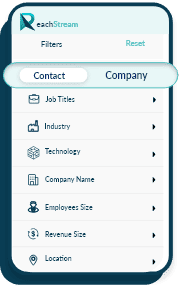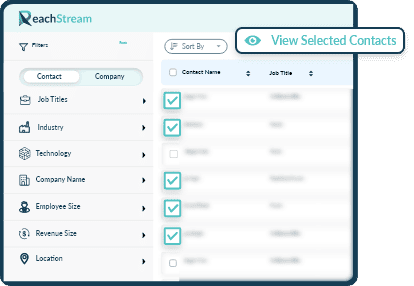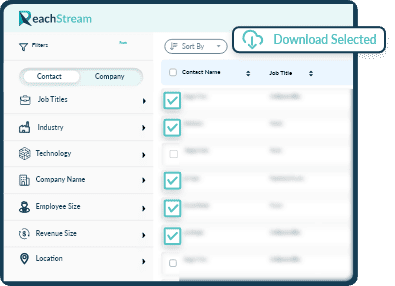
How is your lead-to-conversion rate? Is your sales team managing to fill the funnel with leads but failing to convert them? Then this article is for you.
Scroll down to understand what targeted leads are, how to determine them, and what strategies you can use to get B2B qualified leads that convert.
Targeted leads are prospects with a high propensity to purchase. In other words, these prospects fit your product’s ideal criteria. Like other leads, they can be cold, warm, hot, or of any other kind.
Leads can be classified into different types depending on where they are in the sales funnel.
These prospects have had next to no interaction with your brand. They may or may not know about your product and have little to no interest in exploring or buying it. These leads can be targeted using cold outreach with calls and emails.
Warm leads are companies and people who have shown interest in your brand by visiting your site or social media handles. These leads have a higher chance of closing deals.
These leads show high intent signals and are most likely to buy from you. Hot leads are further along in the sales funnel and require immediate attention for successful conversion. Nurture these leads for higher closing rates.
IQL is a type of warm lead where the prospect has given information about themselves in exchange for resources. They might have provided their email ID for downloading a template or something similar. These are leads that are at the top of your sales funnel.
MQLs have actively engaged in your marketing campaigns by interacting with targeted ads or social media posts. These leads are determined by the marketing team and forwarded to sales for careful nurturing.
These are the leads who are ready to talk to your sales team. SQLs are different from hot leads in that they are not ready to buy, but they are interested in your product and have shown high levels of engagement. Nurture SQLs to turn them into hot leads and close more deals.
Effective sales funnels require an in-depth understanding of leads and lead generation. Determine what type of lead your funnel lacks and create campaigns to generate leads accordingly.
Targeted lead generation is the practice of filtering your total addressable market and determining the highest quality leads. Once the leads are identified, you can nurture them before converting them.
Targeted lead generation involves employing multiple strategies to increase brand identity and awareness for effective conversion.
Increased conversion rates are not the only reason to generate targeted leads. Understanding and actively generating them will allow your sales team to focus on high-quality leads and lower churn rate.
Moving your team’s attention from spray and pray to a smaller segment with better chances of conversion will also reduce your customer acquisition cost and increase ROI.
Now that you know what targeted leads are and why you should look at them, let us look at how to find them.
So far, targeted leads have been defined as companies with a high buying propensity. But how do you determine which company falls under that category?
The answer? Define your ICP, conduct surveys, and analyze your existing customers to get insights into what pain points your product is solving.
Determining your ICP will give you a clear understanding of your total addressable market (TAM). Turning these ideal customers into clients will provide you with a higher ROI and customer satisfaction, and less churn.
Pro Tip: Once you have identified your ICP, you can build a database of potential prospects using ReachStream. Make your custom contacts list and segment them based on popular B2B market segmentation criteria.
Group your market based on firmographics, technographics, customer needs, value to your company, behaviors, and sophistication. Splitting up your market will give your sales and marketing team a road map to personalizing outreach.
Remember that B2B market segmentation differs from B2C; determining a B2B market by demographics will not be as helpful as understanding the organization’s hierarchy.
Use criteria like industry, location, revenue, and employee count to identify how your product can provide solutions. For example, if you manufacture car parts, you might want to identify companies that make cars in bulk— Tesla or Ford.
Selling to smaller companies may be less profitable, and your sales team can prioritize leads from bigger manufacturers.
If you are a SaaS company, you can whisk away your competitors' clients by narrowing down and focusing on specific accounts.
Understand what the prospect's tech stack is. Do you provide easy integration with their existing technology? What problem are you solving that their current software is not?
Group prospects by their buying intent. What are they looking for in a product? Are they productivity-focused? Or do they pay attention to the budget? Perhaps they are looking for an extensive onboarding process.
Segment your prospects by the value or the profit they bring to your company. Keep in mind the acquisition cost, lifetime value, and lead quality. Weigh the revenue your prospects can bring in and split them up accordingly.
Break down your market by their behavior. How do they interact with your brand? What channels do they prefer? How do they use your product? How loyal do you think they will be?
However, take into account that behaviors can change; your accounts are humans, after all.
Does your account know they have a problem? Your sales and marketing approach for a company that acknowledges the problem that your product is solving will be different from one that does not. Determine and group your prospects based on their knowledge of the problem and its solutions.
The next step in increasing conversion rates is incorporating your new knowledge about TAM in your lead generation strategies. Here are some strategies you can try out to reach highly qualified leads.
Access 22M+ pre-qualified prospects and build custom contact lists based on your ideal criteria. Here are some steps you can take to reach highly qualified leads:
Start by creating your freemium account and activating it using the verification link sent to your mail.
Sign in to your free ReachStream account.
Use the filter panel on the left to select your ideal criteria. You can filter for further segmentation.


You can select, remove, sort, or contacts to refine your custom contact list. View details of your prospects by clicking the View Details icon to refine your list further.
Each profile contains 20+ contact and company insights, including:
When you are ready to download your list, click on Download Selected. The list will be downloaded as a .csv file. You can easily import it to your CRM.

You can try ReachStream for free. ReachStream’s Freemium plan offers all features of the Super Saver plan, including advanced API access.
Create highly engaging, quality content that resonates with your ICP. Provide valuable information about your niche by starting a blog section on your website (you can use a content marketing planner if you are new.)
Content marketing can attract traffic to your website and bring in potential prospects who can then later be converted into leads. As your website grows, you will see an increase in brand awareness and trust.
Use social media platforms to reach potential decision-makers and build mutually beneficial relationships with them. Leverage LinkedIn to build networks and share your expertise. Join relevant groups and create a LinkedIn page for your products.
Create a multi-platform campaign to increase brand awareness and presence. You can use a social media strategy calendar or other tools to speed up the process.
Do not underestimate the power of targeted ads. Invest in paid ads on Google, LinkedIn, or Meta to reach your ideal prospects directly. While learning to use Google ads might be a steep curve, it can reach your target accounts effectively.
Research shows that using your existing satisfied customers as a referral base can increase credibility and customer satisfaction. Create referral programs and offer incentives like credit, discounts, etc.
Landing pages are where you can weave your magic. Create compelling, accurate landing pages with a clear call to action to attract leads. Sell your products with good UI/UX and copywriting. You can also add lead magnets like templates, free tools, webinars, and whitepapers to your website.
If you are looking for quick, actionable leads, content marketing, social media, referral programs, and landing pages may not be the best choice.
Instead, you can buy accurate and reliable B2B data from data providers like ReachStream and Cognism. Ensure that the contacts you buy are opt-in data and follow privacy regulations.
You should generate targeted leads to increase lead quality, conversion rate, ROI, customer satisfaction and reduce churn. Which, in turn, will improve your company’s overall growth.
You can target prospects based on your ideal customer profile, firmographics, technographics, needs, value to your company, behavior, and sophistication.
You can build a high-quality targeted leads database using lead magnets and other lead generation strategies. However, if you want accurate, actionable data quickly, you can buy targeted leads from B2B data providers like ReachStream.
A targeted lead generation strategy is where the total addressable market is segmented and strategies like content marketing, social media marketing, paid ads, referral programs, etc. are used to generate leads from different segments.
You can utilize accessible trials from B2B data providers to generate targeted leads for free. For example, ReachStream’s Freemium plan offers all features, including custom list building, advanced API,100 contact views and 25 download credits.
Pitch Your Idea To Your Ideal Customers Today

